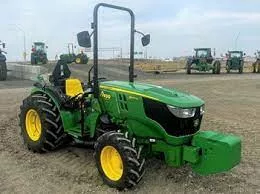
Vehicles & Field Equipment
Oregon-OSHA Requirements
Division 4, Subdivision U: Vehicles
Division 4, Subdivision O: Equipment Guarding
Agricultural Vehicle: A vehicle specifically designed or modified for use exclusively in agricultural operations and not licensed for use on public roads under Oregon laws (includes farm field equipment such as tractors, harvesters, planters, etc.
Commercial-Type Vehicles: Motor vehicles primarily for the transportation of persons or material on roads (includes Class A, B, C, and D vehicles).
Industrial-Type Vehicles: Vehicles designed for non-highway use (power industrial trucks/forklifts, and other vehicles specifically designed for handling materials).
Employees using forklifts, tractors and any equipment with PTOs require training. This training can be conducted by the employer or an outside training entity. Training must be tailored to the specific type of equipment workers will use, the material being handled, and the location of use.
Training Frequency
Training should occur at the time of initial assignment to driving duties, and at least annually after that.
Training Documentation
No training documentation is required.
Training Content
Training should include the following, and any other practices specific to the work environment.
- Securely fasten your seat belt if the tractor has a ROPS (roll-over protective structures).
- Where possible, avoid operating the tractor near ditches, embankments, and holes.
- Reduce speed when turning, crossing slopes and on rough, slick or muddy surfaces.
- Stay off slopes too steep for safe operation.
- Watch where you are going, especially at row ends, on roads and around trees.
- Do not permit others to ride unless there is a safe seat.
- Operate the tractor smoothly – no jerky turns, starts, or stops.
- Hitch only to the drawbar and hitch points recommended by the tractor manufacturer.
- When the tractor is stopped, set brakes securely and use park lock if available.
For Class A and B vehicles operated on public roads (bus that carries 12+ workers or vehicle/van especially built for transporting work crews):
- There must be a first aid kit on the vehicles that is readily available to the driver or crew.
- There must be a B/C fire extinguisher (if vehicle transports workers).
- Nobody may operate any unsafe vehicle. Fix unsafe conditions before operation.
- Only trained and authorized employees may operate any vehicle.
- Only the operator may ride on vehicles unless there are safe riding facilities for additional riders. No one is permitted to ride on fenders, axles, hitches, tongues, buckets, forks, drawbars or any other area not intended for passengers.
- Do not drive a vehicle up to anyone who is in front of a stationary object.
- Operators must look in the direction of travel and have a clear view of the path of travel, unless guided by a signal person.
- Keep manual control over vehicles under tow (except when using a towbar).
- Do not stand or walk under an elevated part of a vehicle unless it is blocked or cribbed.
- Workers may not be under loads or materials during movement.
- Do not overload the vehicle. Keep loads stable and well-balanced.
- Employees must not ride in a loaded or partially loaded cargo space while the vehicle is moving unless the load is adequately shored, braced, or otherwise secured.
- Do not drive a vehicle with an unstable or insecure load.
- When loading Agricultural Vehicles (tractors), Class C Commercial Vehicles (flatbed, pickup body or dump truck), and Industrial-Type Vehicles (forklifts), block the wheels and set the brakes. Not necessary when loading “on the go.”
- The parking brake must be set on parked commercial and industrial vehicles. Block or turn the wheels to a curb when parked on an incline.
- Do not put arms or legs between working parts or outside the running line of the vehicle.
- Vehicles must have a safe way of access and exit.
- Do not jump on or off moving vehicles.
- No stunt driving or horseplay.
Low profile tractors used in orchards and vineyards are not required to use ROPS and seat belts where the vertical clearance would interfere with normal use, and while their use is incidental to the work done in that location (437-004-3600, Section 5).
The orchard exemption is not absolute, and there are times that low-profile tractors may be required to use ROPS in an orchard. If ROPS are not feasible or if it will result in contact with trees, the ROPS can be down. When performing work in and around established blocks of trees (spraying, mowing, chopping brush, hauling fruit bins, moving ladder trailers, etc.), it is not feasible to use ROPS in these cases, nor is it advisable due to damage to the trees as well as potential for injury from branches that catch on the ROPS.
If there is no overhead clearance issue, then ROPS is required, even if it is in an orchard. For example, when tractors are working in orchard blocks where trees have been removed, then ROPS should be used.
Only a driver and one other person may ride in a vehicle hauling explosives.
When the operator of a commercial or industrial vehicle is not at the controls, the brakes must be set or the wheels blocked. Fully lower or block elevated attachments. Unattended vehicles must be shut off. If parked on a slope the wheels of commercial and industrial vehicles must be blocked or chocked.
There are specific requirements for passenger compartments, windshields/windows, brakes, steering and lights. See Subdivision U, section 437-004-3410 for more information.
- Check vehicles as often as needed to assure that they are in safe operating condition and free of damage that could cause failure while in use.
- Before using it, fix defects that affect the safe operation of the vehicle.
- Do not continue to use a vehicle that becomes unsafe during use.
- Block or crib heavy machinery, equipment, elevated parts, or parts supported by slings/hoists/jacks/other devices to prevent falling or shifting before employees work under or between them.
- All controls must be in neutral with motors off and brakes set, unless the work requires otherwise.
- Disconnect battery when repairing the electrical system if injury could occur by closing of the circuit.
- Vehicles with dump bodies or other elevating parts must have positive means of support, permanently attached, and capable of being locked in position to prevent accidental lowering of the body. This device must support a raised body during maintenance or inspection work.
Do not transport workers in flatbed trucks, dump trucks and pickups UNLESS:
- Tilting, sliding, or moveable decks or bodies are secured to prevent accidental movement.
- Flatbed vehicles without seats must have sides and end gates at least 24 inches high. Workers must sit on the floor.
- Close pickup and dump truck tailgates and make workers sit on the floor unless there are seats secured in place and sides at least 42 inches high. Chain or rope must be across the rear of such vehicles with seats.
- When workers sit on low boxes or similar equipment, there must be side rail at least 36 inches.
- In Class A and B commercial vehicles (bus that carries 12+ workers or vehicle/van especially built for transporting work crews separate from space used to transport supplies and tools), workers must not sit on the floor in aisles while the vehicle is moving.
- No smoking or open fires, flame or source of ignition within 35 feet when fueling vehicles.
- Stop engines (except diesels) when fueling.
- Refilling vehicle tanks that use liquified petroleum gases must be done outside.
- Do not transport gasoline and other flammable liquids on commercial vehicles carrying workers, unless it is 5 gallons or less capacity and the containers are accepted, labeled and listed. Do not carry containers inside the passenger compartment, and secure containers to prevent shifting.
Vehicles must display slow-moving vehicle signs if they are designed for use at speeds of less than 25 miles per hour and Class I all-terrain vehicles operated on a highway. Emblems must be displayed on the rear of the power unit.
An implement of husbandry (IoH) is a vehicle or piece of equipment used exclusively for agricultural operations (farm tractors, combines), equipment used for tilling/planting, harvesting/cultivation, equipment used to apply fertilizer or pesticides.
- Should be driven as closely as practical to the right-hand edge of the roadbed, including shoulders.
- If movement occurs during darkness, the vehicle must be equipped with 2 headlights, clearance lights and reflectors marking overall width that is visible from the front/rear/sides, and a tail light.
- Must display a slow-moving vehicle emblem.
- Roads must be wide enough to allow safe operation of equipment.
- Low clearance areas that could present a hazard must have warning signs.
- Do not drive vehicles on or over broken planking, deep holes, large rocks, logs or other dangerous surface defects.
- Remove obstructions to clear view at intersections or sharp curves, or take precautions to relieve the hazards.
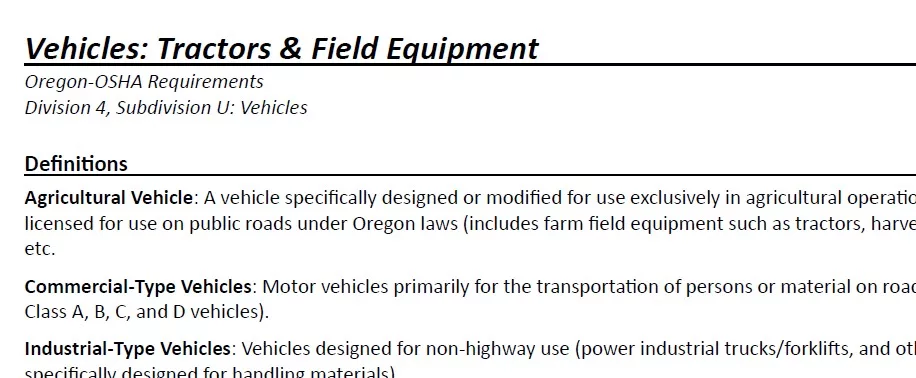
Printable Tractors & Field Equipment Summary
A printable PDF summary of OR-OSHA’s tractors and field equipment rules.

OR-OSHA Division 4 Rule Text: Vehicles
Read OR-OSHA’s Division 4 rules about vehicles.
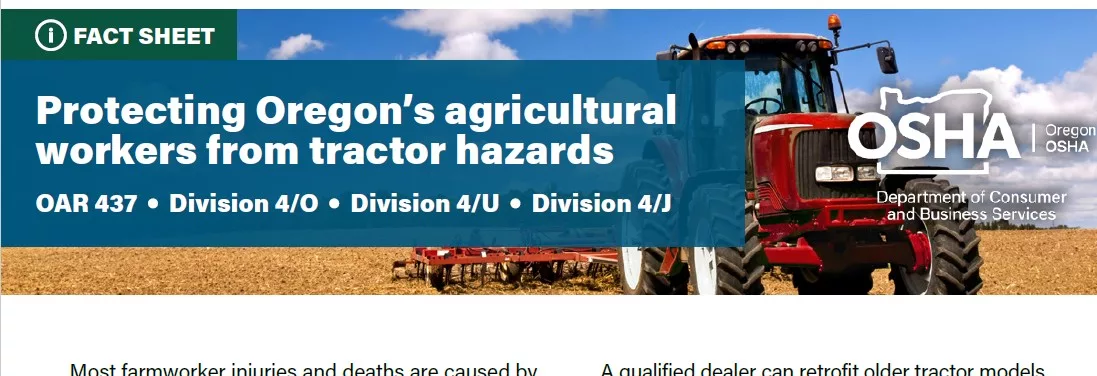
Fact Sheet: Protecting from Tractor Hazards
Read OR-OSHA’s fact sheet about protecting from tractor hazards in agriculture.
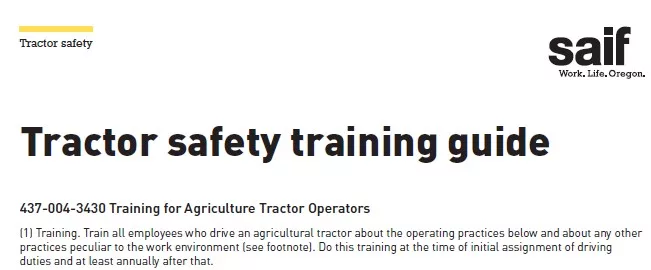
Tractor Safety Training Guide
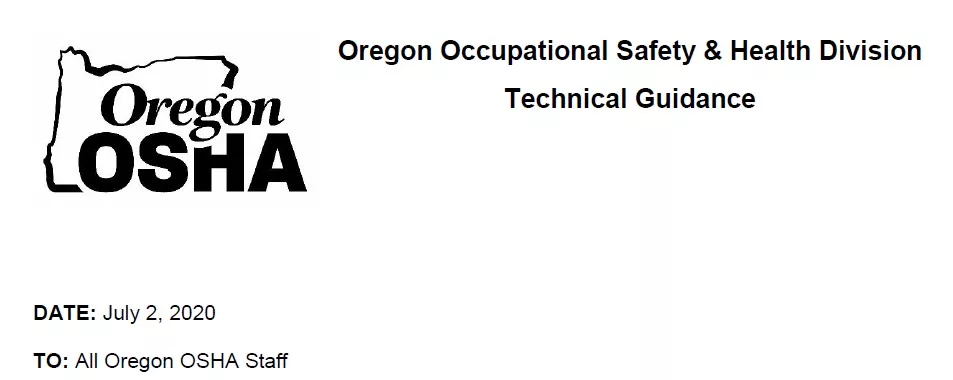
Clarification for Use of ROPS
Read OR-OSHA’s clarifications on exemptions from the use of Roll Over Protection Structures in low-profile tractors and side-by-side all-terrain vehicles.
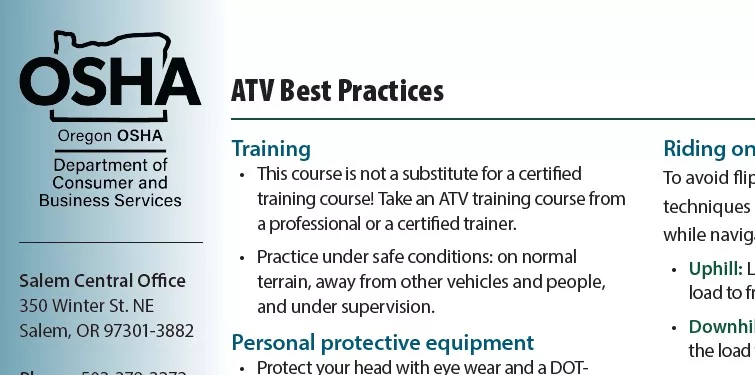
ATV Best Practices
Every employee should be instructed about the safe operation and servicing of all equipment they will use.
This training can be conducted by the employer or an outside training entity. Training must be tailored to the specific type of equipment workers will use, the material being handled, and the location of use.
Training Frequency
This training should occur at the time of initial assignment to use equipment, and at least annually after.
Training Documentation
No training documentation is required.
Training Content
Training should include, at a minimum:
- Keep all guards in place when the machine is in use.
- Permit no riders on farm field equipment other than the person(s) required for instruction or assistance.
- Stop the engine, disconnect the power source and wait for all machine movement to stop before servicing, adjusting, cleaning, or unclogging the equipment.
- Instruct employees in the safe procedures necessary to service or maintain the equipment when it must remain running.
- Make sure everyone is clear of machinery before starting the engine, engaging power, or operating the machine.
- Establishments will use a lockout/tagout system for any equipment that needs repair and should not be in service; employees should know what the lockout/tagout system is and what labels to look for.
- Guard all power take-off (PTO) shafts with a master shield or other protective guarding.
- Tractors must have a shield or guard strong enough to support the operator if they get on or off the tractor using the shield as a step.
- There must be signs on tractors and PTO driven equipment to remind operators to keep safety shields in place.
- Guard (as much as possible) all moving parts that must be exposed to operate on farm field equipment. Examples include flail rotors, rotary beaters, mixing augers, conveying augers, rotary tillers, etc.
- Ensure the guard does not interfere with the normal operation of the equipment.
Ensure that guards, shields, and access doors are in place when equipment is running.
Where removal of a guard will expose an employee to a part that continues to rotate after power is disengaged, provide:
- A readily visible or audible warning of rotation
- A safety sign warning the employee to look and listen for evidence of rotation and not remove the guard until all components stop.
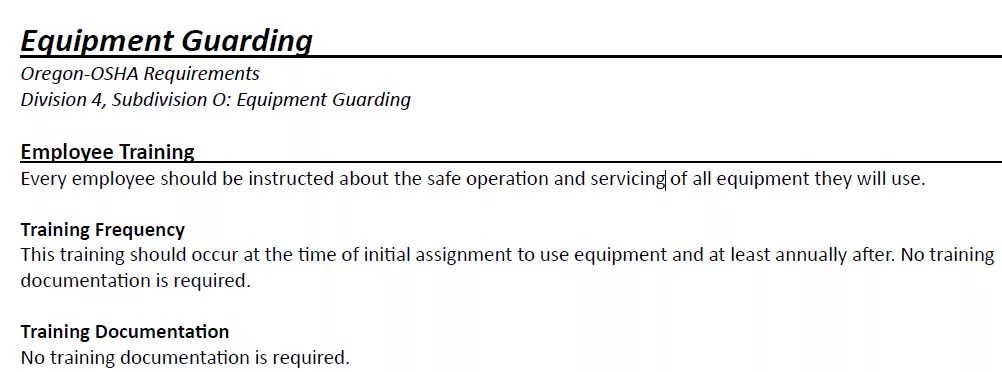
Printable Equipment Guarding Summary
A printable PDF summary of OR-OSHA’s equipment guarding rules.

OR-OSHA Division 4 Rule Text: Equipment Guarding
Read OR-OSHA’s Division 4 rules about equipment guarding.
